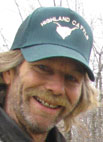
Lightening Ridge Farm is a long way from the Scottish Highlands, but the terrain and weather conditions haven’t been much different here in the Missouri Ozarks. Near the southern line of Texas County, on the headwaters of Jack’s Fork River, the hills are steep and live water from springs is abundant. Dave and Ruth Embry raise Highland cattle on their 150-acre farm that is mostly wooded with about 20 acres open. You might think it would be impossible to raise livestock in these conditions, but their Highland cattle are thriving here.
“Highland cattle are browsers,” Dave said, “sort of like a goat. They can graze in the woods and are good for land clearing. Highlands are able to digest low-grade forage, even acorns, and still do well.” These calm, easy keeping cattle are known for their problem-free calving, vigor, longevity and herd instinct. In other words, they haven’t been domesticated completely and the survival instinct hasn’t been bred out of them.
The Embrys calve in late fall and winter with no problems. “The calves are born with a long fur coat and the cold weather doesn’t bother them,” Ruth said, adding, “The whole herd seems to baby sit the calves, similar to the elephant’s behavior – very protective.”
Dave and Ruth come from totally different backgrounds. Dave was born on a hog farm in Michigan and Ruth is from Long Island, N.Y. They got together here in the Missouri Ozarks, when Dave was looking for a farm he could afford. When they saw the Highland Cattle shown at the Cabool Farm Fest in 1998, they only had one Jersey milk cow. They knew they had found the right breed for them when they learned about their foraging ability and hardiness.
“We can sell all we can produce,” Dave said, “as registered herd bulls or for cross-breeding. Heifers are sold registered for seed-stock.” They are experimenting with cross-breeding with Jerseys to produce a rugged, high producing milk cow.
“Highland beef is comparable to buffalo and venison,” Ruth said, “low in fat and cholesterol.” When asked about their feeding and medical procedures, Dave said, “We give the herd worm blocks for parasites instead of shots.” The cattle forage for food except in the winter. When feeding hay the Embrys start out in the fall feeding the lower grade hay, and proceed through the winter with better and better hay as the winter progresses and the cattle need more protein. Dave said, “We kept mineral blocks or mineral mix available for the entire herd 24/7, 365 days a year. Range cubes are used periodically, not only because they like them but as a training tool for halter breaking, loading, etc.”
Besides running the farm Dave works five days a week at Wake’s Feeds in Willow Springs, Mo., and in the summertime he works with a hay crew that does custom baling in the area. Ruth manages the house and raises a big garden every year. They are active in the Heartland Highland Cattle Association with Dave as the current president of the organization.
Dave and Ruth host a farm fest or “open house” every 4th of July holiday weekend at their farm. They have Highland officials on hand as speakers, and people can see for themselves their cattle, and their environment in its natural state. Ruth said, “We serve Highland beef and no one goes hungry.” Dave said, “Our guests can see from year-to-year how the cattle have cleared out our woods. Soon it will look like a park around here.”







